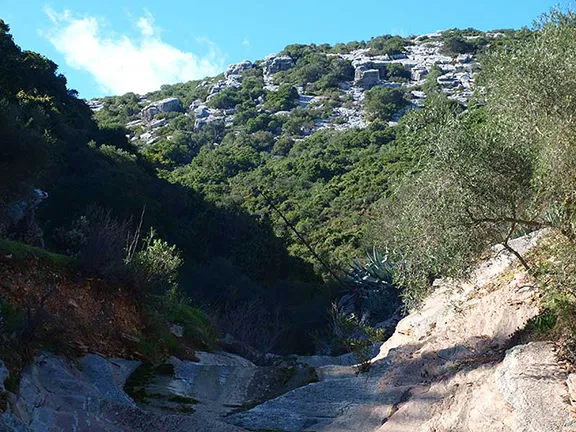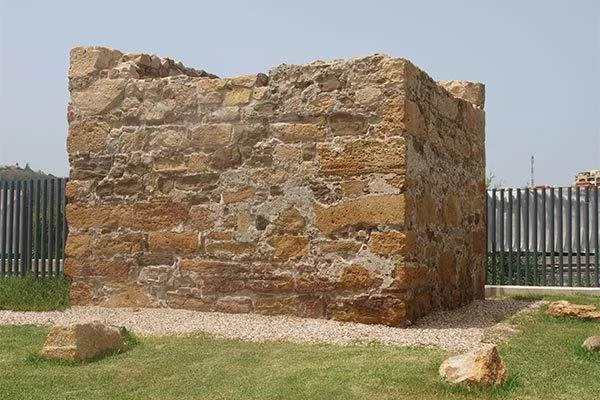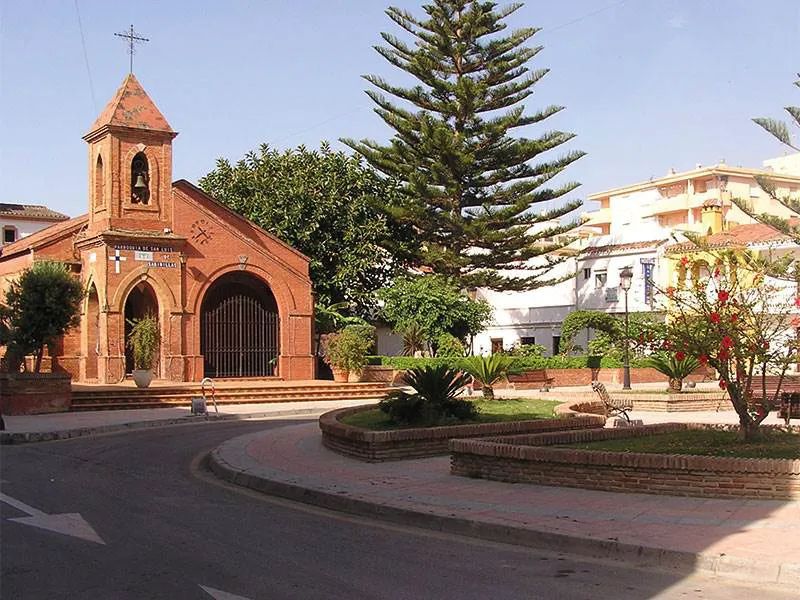Manilva is an unexplored municipality on the Costa del Sol. Manilva is inland from the coast with three seaside villages, Sabinillas, Puerto Duquesa and Castillo
By Nick Nutter | Updated 17 Aug 2023 | Málaga | Villages |
Login to add to YOUR Favourites or Read Later
.webp)
-sm.webp)
Castillo and Puerto de la Duquesa
Mention Manilva to the average person in the UK and they will probably ask you where it is. Some may hazard a guess that it is in the Philippines, confused by the similarly named Manila, the capital of that country. Indeed, until recently, some of the post for Manilva used to end up there, so much in fact that the Manila postal authorities had a special sack for Manilva. But that is another story.
This article looks at Manilva and the fascinating history of the area right on our own doorstep, much of it hidden now by high rise buildings, but, look further, and you will be surprised what lies beneath and behind.


Utrera Gorge
The municipality of Manilva is the furthest part south west in the province of Málaga and comprises the towns and villages of Manilva itself, San Luis de Sabinillas, Puerto de la Duquesa, Castillo de la Duquesa and Hondacavada, the area inland from the southern most coastal urbanisation Martagina.
The first evidence of habitation in the area is found in caves in the Sierra de la Utrera. If you look inland from the Estepona side of Sabinillas you will see, on the horizon, a limestone escarpment, the sierra. In the centre is a ‘U’ shaped gorge, Utrera. If you are fit enough there is a fabulous walk along the Roman Oasis road, under the A7 toll road and up the gorge to emerge on the Manilva to Casares road, it is about 12 kilometres for the round trip.


Manilva Wine
Neolithic people, the first farmers around 6,000 BC, evidently found the land to their taste and left behind their tools and later, pots, to show they had been there. Much later, about 3,000 BC man was still occupying the area and there are many archaeological sites dating from this 3000 year period.
The Bronze Age site at Cerro del Castillo which is a prominent hill 2.5 kilometres west of Martagina, adjacent to the toll road is largely unexcavated. So far it consists of a fortified site on the hill itself and a farming community in the valley below. Some of the artifacts are displayed in the museum in the castle at Castillo de la Duquesa. It is tantalising to think that these people after 1,000 BC may have had trading links with the Tartessians based around Huelva, for this area was within their territory, and with the Phoenicians who were then expanding their own trading networks down our coast and as far as Cádiz.


Torre de la Duquesa
The Phoenicians, with the local inhabitants, may well have established the first permanent settlement in the area at Castillo de la Duquesa. Certainly by the time the Romans arrived there was a settlement there that they expanded. It may have been called Saltum. The Romans had a habit of retaining and adopting any technology that they found in conquered lands.
One such example here is the fish salting and manufacture of a foul smelling concoction called garum. If you walk the beach from Puerto de la Duquesa to Castillo, just past the Los Flamencos urbanisation, now built upon, there was an extensive Roman cemetery. Next to that is a huge fish-processing factory that is still partly visible alongside the more recent apartment blocks. Across the road from the N340 to Castillo the foundations and mosaics open to the elements were part of a residential area and, at the eastern side of the Plaza Banos Romanos in Castillo itself there are the remains of a Roman villa together with its own private bath house.
Looking inland you will see the hill behind Duquesa Golf, known as El Hacho. Here there was a tower dating back to the Roman period. About 4 kilometres up the Rio Manilva and still in use today are the Roman Baths situated at a point where a hot sulphur spring emerges from the hill below the Sierra de la Utrera.
Already the area was well known for its olives, grapes and fishing and those products were shipped to all parts of the Roman Empire in amphora manufactured in the Málaga region. Following the Romans there is little evidence of any of the succeeding invaders of Andalucia. The Visigoths may have been here but there is no evidence to suggest that. The Moorish invasion of 711 AD and their subsequent occupation until the 15th century has left little trace.
The remains of the tower at Punta de la Chullera are thought to date from this period. It was one of a chain of torres built to allow warning of pirates. Another tower, at the entrance to the Bella Vista Camp Site just west of Castillo, was only recently discovered when a venta was demolished. The tower formed part of the kitchen area.


Castillo Castle
For the people that lived here it seems that little changed in the thousand years between 400 AD and the re-conquest in the 15th century. They fished, grew olives and grapes and started to cultivate grain crops, and then they were again disturbed. This time by Barbary pirates from the coast of North Africa.
Such was the frequency of their raids that in the late 15th and early 16th centuries, the population withdrew inland to the more easily defended villages of Casares and Gaucin. They returned to the coast on a daily basis to fish, the catch being taken back to the villages by donkey. Some of these well-worn trails are still passable on foot. One continues beyond the Roman Baths to Casares and further to Gaucin, either leg is a strenuous walk but well worth the effort, particularly the kilometre or so above the baths where the trail clings to the side of a spectacular limestone gorge.The pirates were more than a nuisance. They frequently took advantage of the depopulated coast to land large forces that then threatened Gibraltar, Marbella and Ronda. Those towns complained to the king, Charles V, who, in 1528 ordered a tower to be built at Salto de la Mora (Moorish Woman’s Leap). It is still there and is now called Torre de la Sal on the coast below Bahia Casares. The building of this tower was accomplished by the Duke of Arcos who owned the land.


Sabinillas Church
In 1530 the Duke of Arcos, in an effort to re-populate the land, encouraged people to settle on a hill called Los Mártires by giving them parcels of land to work. A church was built, Santa Anna and the town of Manilva was founded.
The original church was destroyed in an earthquake in 1722 and rebuilt in 1776 in Calle Iglesia. At this time Manilva was part of the municipality of Casares and remained so until it was given the ‘royal privilege of town’ on the 26th October 1796 after a legal dispute that lasted almost 100 years.
Meanwhile in 1767, King Carlos III decided to strengthen the coastal defences and ordered Francisco Paulino of Seville to build a castle at Castillo de la Duquesa. This was built on the foundations of a Roman building and served as the headquarters for a company of cavalry. The castle was manned through the Napoleonic and Peninsula wars although no major battles were fought in the Manilva area. Following this period the castle became home to a number of families up until the second half of the 20th century. There are still people living in Castillo that previously lived in the castle.
Gradually the pirates became less of a threat. They finally ceased to exist as an effective force in 1801 after the United States Navy destroyed their power bases in Morocco, Tunisia and Algeria. This period of relative peace between the mid 18th century and mid 19th century allowed the population to build mills to grind grain. A succession of them can be seen, most now in ruins, up the Rio Manilva valley as far as Casares. An elaborate system of aqueducts was built to bring water from the upper parts of the river down to the last mill that can be seen on the right hand side of the Roman Oasis road about 2 kilometres from Sabinillas.
Meanwhile another crop was introduced into the area, sugar cane. It is just as well for in the 1860’s the grapes were wiped out by a European wide outbreak of phylloxera.
The cane was processed at a factory in Sabinillas that was built where the Colonia de Infantil building is now between Sabinillas and Puerto de la Duquesa.
Again the area was left to its own devices, little bothered by foreign affairs or even affairs within Spain. Manilva was a small farming community; Sabinillas and Castillo were tiny fishing villages with fishermen’s cottages on the beach.
Until 1936 that is, when the Spanish Civil War erupted setting village against its neighbouring villages and even sons against fathers. Much of the action took place along the coastal strip in Andalucia and Laurie Lee in his book ‘As I Walked Out One Midsummer Morning’ describes the deprivations of the times far better than I can. At one stage Mussolini marched his Italian fascist troops down the N340 through Sabinillas and the German battleship Graf Spee was frequently seen patrolling off the coast.
By 1939 the heart had been ripped out of Spain leaving the country all but bankrupt and with a starving population. The following years are known as the ‘Years of Starvation’ and large parts of the rural community moved to the towns and cities for work and food. Even today villages arrange transport from the cities to bring back the older former residents for family reunions once a year, the famous Romerias.
In the late 1950s and early 1960s, Marbella was enjoying the first of the tourists and urbanisations were being thrown up from Puerto Banus to Malaga and beyond. Manilva, being just that little bit further from the airport, only saw those brave enough to drive their hire cars down the single track N340 as it was then.
Puerto de la Duquesa was about the only concession made to the tourist industry and a few apartment blocks were built in Sabinillas to cope with the even fewer ex pats who arrived determined to sample the ‘real Spain’, which they could in Manilva.
Very slowly and very gradually the numbers of visitors increased as did the number of resident ex pats but even today Manilva does not have the hills to sea block of solid concrete apartments, hotels and urbanisations you see at the eastern end of the Costa del Sol.
Although grape vines had been re-introduced to the Manilva area just after the Civil War, it is only recently that Manilva has started to emerge from beneath the blanket of Malaga Wine and Malaga Raisins.
The Malaga DO region, established in 1933, includes Manilva and the Moscatel grapes grown on the white soil of Manilva contribute to the overall production of Malaga wine, primarily the sweet Moscatel for which Malaga is famous. Similarly the grapes left to partially dry in the sun contributed to the overall production of Pasas de Malaga, Malaga Raisins. Only a limited supply of specifically Manilva wine could be obtained in plastic bottles from local supermarkets; until 2014 that is.
An enterprising local man, Argimiro Martinez Moreno started a business, Nilva Enoturismo SL. Under the Nilva label Argimiro is producing about 6,000 litres of wine per year from the locally grown Moscatel grape. The first, a white seco, is reminiscent of a fino sherry from Jerez and Argimiro tells us this is due to the similar soil in which the grapes are grown. The second is a semi-seco produced from grapes that have been left in the sun for 2 days. The third is a sweet desert wine produced from grapes left in the sun for up to six days.
When not supervising the wine making, Argimiro runs the wine museum, a comprehensive account of the winemaking history of the area, all in Spanish, and offers wine for tasting from the small shop. He is also hopeful of gaining a coveted label for Manilva wines.
The first weekend in September is when the Vendimia de Manilva takes place.
Started in the 1960s this grape festival is hugely popular and draws in hundreds of people. The festival starts on the Saturday morning and lasts until the early hours of Monday. Monday itself is a local holiday. You can expect a procession, street stalls, flamenco dancing, music, grape treading in the traditional manner on the Sunday evening followed by live music and dancing. You will also be able to sample this year’s grapes and wine.
Read more about the Manilva Grape Harvest Festival here.
Manilva is a municipality that is carefully bringing itself into the 21st century.
It is a balancing act between the desire to remain Spanish, a sentiment shared by many of the ex-pats who live here as well as the Spanish themselves, creating new industry that blends in with the landscape and catering for the annual visitors who provide the ‘icing on the cake’ for many local and ex-pat businesses. It is a balance between providing accommodation for residents and visitors without ruining the environment or running out of essential commodities such as water and power.
To date, Manilva is managing to adjust and develop without losing its identity expressed in so many fiestas and ferias throughout the year.
As Manilva is still mostly a hidden gem from the tourist hoards in Costa del Sol, you’ll find mostly apartment rentals here instead of hotels and resorts. Here are some places to stay you can consider:
If you prefer a place by the coast, you can also consider staying in the nearby Puerta de la Duquesa or San Luis de Sabinillas.
Or check out the latest deals in Manilva below.
Booking.com
Travelling to/around Spain and need some help? Here are our favourite travel resources.
We usually use Booking.com to look for hotels or apartment rentals. Lots of choice & you can unlock more discounts with their Genius loyalty programme!
To research transportation options around Spain, we like using Omio. It’s an easy way to compare different modes of transport and prices in one place.
For last-minute holiday deals, check out Expedia UK.
Looking for things to do? Viator has a huge catalog of activities and tours across many cities in Spain. We also love Get Your Guide!
Guruwalk is our favourite platform to find the best free walking tours in a city.
For money transfers or spending overseas in foreign currency, Wise is our favorite borderless banking service.
Travel insurance is a must to protect against emergencies and unexpected incidents. Get a quote from SafetyWing here.